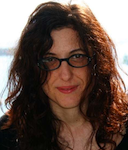Lucia Dacome
My research interests focus on themes related the social, cultural, and material histories of bodies, health and medicine, the histories of women and gender, and the histories of slavery and race in early modern Italy and the Mediterranean world.
I am currently working on a book-length project that studies the entanglements of slavery, medicine, and natural inquiry in early modern Italy. I focus on Tuscany, and especially on the port city of Livorno, which long operated as a center of galley slavery and was characterized by the presence of a large community of captives from the Muslim Mediterranean world and beyond. For one thing, I consider how medicine and natural inquiry participated in the institution of slavery and examine the involvement of medical practitioners and natural inquirers in the world of slavery. Likewise, I analyze the medical infrastructure that was deployed to manage captives’ health, disability, and sickness, and trace how medical observation and practice intersected with the demands of inspection, control, and surveillance that marked the enslavement apparatus. For another thing, I investigate how captives participated in medical and natural pursuits and explore their roles as bearers of healing and knowledge. For instance, I investigate captives’ involvement in savants’ networks and examine the spaces of encounter, interaction, and information exchange between the enslaved community and the free population, like the shops and stalls – and especially the barbershops and coffeeshops – which were run by captives when they were not coerced to row or labour. This research has been supported by several funding bodies, including The Jackman Humanities Institute, I Tatti-The Harvard University Center for Italian Renaissance Studies, the Pauline Mazumdar Fund, and SSHRC.
Before joining the University of Toronto, I held postdoctoral fellowships at the Max Planck Institute for the History of Science, the Wellcome Trust Centre for the History of Medicine at UCL, the UCLA Center for 17th- and 18th- Centuries Studies/Clark Library, and a Marie Curie Intra-European Fellowship from the European Commission at Centre Alexandre Koyré/CNRS.
People Type:
Roles:
Research Area:
Books
Malleable Anatomies: Models, Makers, and Material Culture in Eighteenth-Century Italy (Oxford: Oxford University Press, Past and Present Book Series, 2017).
Edited Volumes
Unruly Objects: Material Entanglements in the Arts and Sciences, Special Issue, Nuncius: Journal of the Material and Visual History of Science, 2020, 35:3, pp. 461–717 (co-edited with Meghan Doherty, Dahlia Porter, Courtney Roby).
Articles
“Between Land and Sea: Medicine and Galley Slavery in Early Modern Tuscany,” in Sandra Cavallo and John Henderson (eds.), Medicine in Early Modern Italy: between Theory and Practice (Brepols, 2024), in press.
“An Island in the City: Ancona’s New Lazaretto as a Medical, Political, and Religious Borderland,” Eighteenth-Century Studies 57:3 (2024), pp. 325–52.
“Intimate Connections: Marie Marguerite Biheron and her ‘Little Boudoir,’” Bulletin of the History of Medicine 95 (2021), pp. 315-349. Recipient of the 2024 Percy G. Adams Prize.
“Introduction,” Unruly Objects: Material Entanglements in the Arts and Sciences, Special Issue, co-edited by Lucia Dacome, Meghan Doherty, Dahlia Porter, Courtney Ann Roby, Nuncius: Journal of the Material and Visual History of Science 35:3 (2020), pp. 461–70 (with M. Doherty, D. Porter, C. Roby).
“‘Une dentelle très bien agencée et très precise’: les femmes et l’anatomie dans l’Europe du dix-huitième siècle,” in Adeline Gargam (ed.), Femmes de sciences de l'Antiquité au XIXe siècle: Réalités et representations (Dijon: Editions Universitaires de Dijon, 2014), pp. 157–75.
“Ai confini del mondo naturale: anatomia e santità nell’opera di Prospero Lambertini,” in Maria Teresa Fattori (ed.,) Storia, medicina e diritto nei trattati di Prospero Lambertini - Benedetto XIV (Rome: Edizioni di Storia e Letteratura, 2013), pp. 318–38.
“Balancing Acts: Picturing Perspiration in the Long Eighteenth Century,” Studies in History and Philosophy of Biological and Biomedical Sciences, 43 (2012), pp. 379–91.
“The Anatomy of the Pope,” in M. P. Donato and J. Kraye (eds.), Conflicting Duties: Science, Medicine and Religion in Rome, 1550-1750 (London: the Warburg Institute, 2009), pp. 353–74.
“Women, Wax and Anatomy in the ‘Century of Things’,” Renaissance Studies, 21:4 (2007), pp. 522–50.
“Fabricating the Body: The Anatomical Machines of the Prince of Sansevero,” in V. Greene et al., Objects Specialty Group; Proceedings of the Objects Specialty Group Session, 35th Annual Meeting of the American Institute of Conservation (Washington: American Institute for Conservation of Historic & Artistic Works, 2008), pp. 161–77 (with R. Peters).
“Resurrecting by Numbers in Eighteenth-Century England,” Past and Present 193 (2006), pp. 73–110.
“Waxworks and the Performance of Anatomy in Mid-Eighteenth-Century Italy,” Endeavour 30:1 (2006), pp. 29–35.
“Healing the Sick and Feeding the Dead: Nutrition, Digestion and Regeneration in Eighteenth-Century Britain,” in RuBrica, Special issue, S. Soupel (ed.), Nourriture(s) / “nourishment” en Grande-Bretagne au XVIII siècle 14 (2006), pp. 317–26.
“‘Useless and Pernicious Matter’: Corpulence in Eighteenth-Century Britain,” in A. Carden-Coyne and C. Forth (eds.), Cultures of the Abdomen: Diet, Digestion and Fat in the Modern World (New York, Palgrave, 2005), pp. 185–204.
“‘Un certo e quasi incredibile piacere’: cera e anatomia nel Settecento,” Intersezioni, 23:3 (2005), pp. 415–36.
“Noting the Mind: Commonplace Books and the Pursuit of the Self in the Eighteenth Century,” Journal of the History of Ideas 65:4 (2004), pp. 603–25.
“‘To What Purpose Does It Think?’: Dreams, Sick Bodies, and Confused Minds in the Age of Reason,” History of Psychiatry 1:4 (2004), pp. 395–416. Recipient of the 2006 Percy G. Adams Prize.
“Living with the Chair: Private Excreta, Collective Health and Medical Authority in the Eighteenth Century,” History of Science 39 (2001), pp. 467–500.
“From Parsnips to Eternity: Dieting in Straight Lines,” in A. Cunningham and N. Jardine (eds.), Garden Party Talks 2: On Food (Cambridge: The Cambridge Group for the History of Natural History and the Environmental Sciences, Cambridge University, 1998), pp. 25–39.
PhD Supervisions
Myriam Iuorio, “Images of Disability: Italian Missionary Narratives in Early Modern Africa,” 2021 – present.
Oana Baboi, “Healing the Body to Save the Soul: Jesuit Medicine in 16th-17th Century Portuguese Empire in Asia” (PhD defended in May 2022).
Esther Atkinson, “Anomalous Bodies: Representations of Children’s Deformities in Britain, 1740-1790” (PhD defended in October 2021).
Erich Weidenhammer (co-supervisor with Trevor Levere), “Air, Disease, and Improvement in Eighteenth-Century Britain: Sir John Pringle (1707-1782)”, 2010–2014 (PhD defended in July 2014).
Jaipreet Virdi, “‘From the Hands of Quacks’: Aural Surgery, Deafness, and the Making of a Specialty in 19th C London”, 2008–2014 (PhD defended in June 2014).
John Christopoulos, “Abortion in Renaissance Italy”, 2007–2012 (PhD defended in December 2012).
Delia Gavrus (co-supervisor with Pauline M. H. Mazumdar), “Men of Strong Opinions: Identity, Self-Representation, and the Performance of Neurosurgery, 1919-1950” (PhD defended in October 2011).
Brigit Ramsingh (co-supervisor with Pauline M. H. Mazumdar) “The History of International Food Safety Standards and the Codex Alimentarius (1955-1995)” (PhD defended in May 2011).
PhD Supervisory Committees
Denisa Popa, IHPST, 2021 – present
Kathleen Burke, History Department - PhD defended in August 2022
Jennifer Fraser, IHPST, PhD defended in May 2022
Spirit Waite, History Department - PhD defended in April 2021
Julia Rombough, History Department - PhD defended in August 2019
Clara Steinhagen, IHPST, 2016–2023
Kelsy Vivash, The Centre for Drama, Theatre and Performance Studies, 2013–2017
Vivien Hamilton, IHPST, PhD defended in September 2012
Sheena Sommers, History Department, 2007–2012



